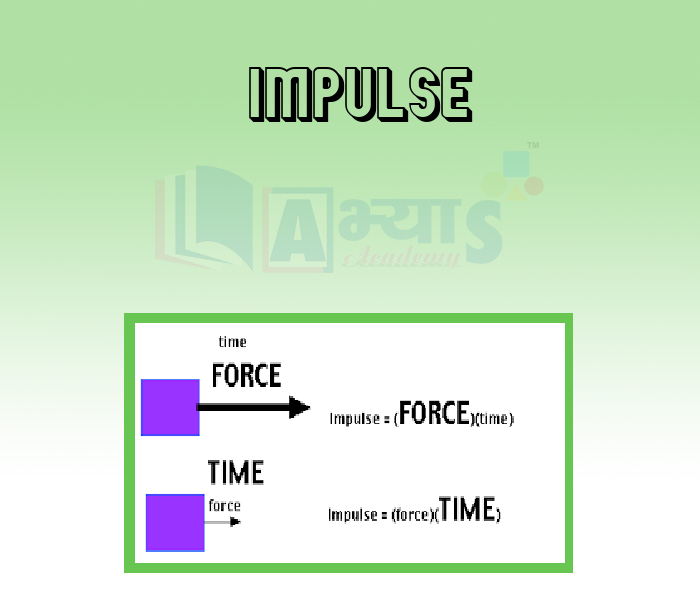Impulse










Impulse
It is termed as the total impact of force. This is equal to the change in momentum of the body. In other words, impulse is defined as the product of force and a small time in which the force acts.
SI unit of Impulse if N s (Newton Second) or kgm/s.
Impulse Equation:
Impulse is often stated to be the product of the average net force that acts on an object for a ceratin duration.The equation for impulse is given as;
Note : We assume that force is constant over time.
Impulse is a vector quantity like force and it also has direction.
Impulse - Momentum Theorem
The Impulse-Momentum theorem helps us establish the relation between the two concepts. The theorem basically states that the change that is seen in the momentum of an object is equivalent to the amount of impulse exerted on it.
Basically, you should understand that impulse is a measure of how much the momentum changes. Here we also get an alternative formula which is given as;
Where initial momentum,
final momentum
With this formula,we can further clearly relate impulse to the chnges in the momentum of the object.
Q.A 650 - kilogram rocket is to be speed up from 440 meters per second to 520 meters per second in outer space. If the thrust of the engine is 1200 newtons, for how long must the engine be fired?
Solution: The change in the momentum of the rocket
= (650)(520) - (650)(440) = 52000 kg m/s.
This must be equal to the impulse, so = (1200N)(t) = 52000 kg m/s
Therefore , = 43 s
A stationary ball weighing 0.25 kg acquires a speed of 10 m/s when hit by a hockey stick. The impulse imparted to the ball is _____________ | |||
| Right Option : A | |||
| View Explanation | |||
The velocity of a car of mass 3000 kg is changed from 18km/hr by applying a constant force . The impluse of the constant force acts. | |||
| Right Option : A | |||
| View Explanation | |||
The direction of impulse is | |||
| Right Option : A | |||
| View Explanation | |||
Students / Parents Reviews [10]
One of the best institutes to develope a child interest in studies.Provides SST and English knowledge also unlike other institutes. Teachers are co operative and friendly online tests andPPT develope practical knowledge also.

Aman Kumar Shrivastava
10thAbhyas is a complete education Institute. Here extreme care is taken by teacher with the help of regular exam. Extra classes also conducted by the institute, if the student is weak.

Om Umang
10thIt was good as the experience because as we had come here we had been improved in a such envirnment created here.Extra is taught which is beneficial for future.

Eshan Arora
8thAbhyas Methodology is very good. It is based on according to student and each child manages accordingly to its properly. Methodology has improved the abilities of students to shine them in future.

Manish Kumar
10thA marvelous experience with Abhyas. I am glad to share that my ward has achieved more than enough at the Ambala ABHYAS centre. Years have passed on and more and more he has gained. May the centre flourish and develop day by day by the grace of God.

Archit Segal
7thIt has a great methodology. Students here can get analysis to their test quickly.We can learn easily through PPTs and the testing methods are good. We know that where we have to practice

Barkha Arora
10thIt was a good experience with Abhyas Academy. I even faced problems in starting but slowly and steadily overcomed. Especially reasoning classes helped me a lot.

Cheshta
10thMy experience with Abhyas is very good. I have learnt many things here like vedic maths and reasoning also. Teachers here first take our doubts and then there are assignments to verify our weak points.

Shivam Rana
7thMy experience with Abhyas academy is very good. I did not think that my every subject coming here will be so strong. The main thing is that the online tests had made me learn here more things.

Hiya Gupta
8thMy experience was very good with Abhyas academy. I am studying here from 6th class and I am satisfied by its results in my life. I improved a lot here ahead of school syllabus.
